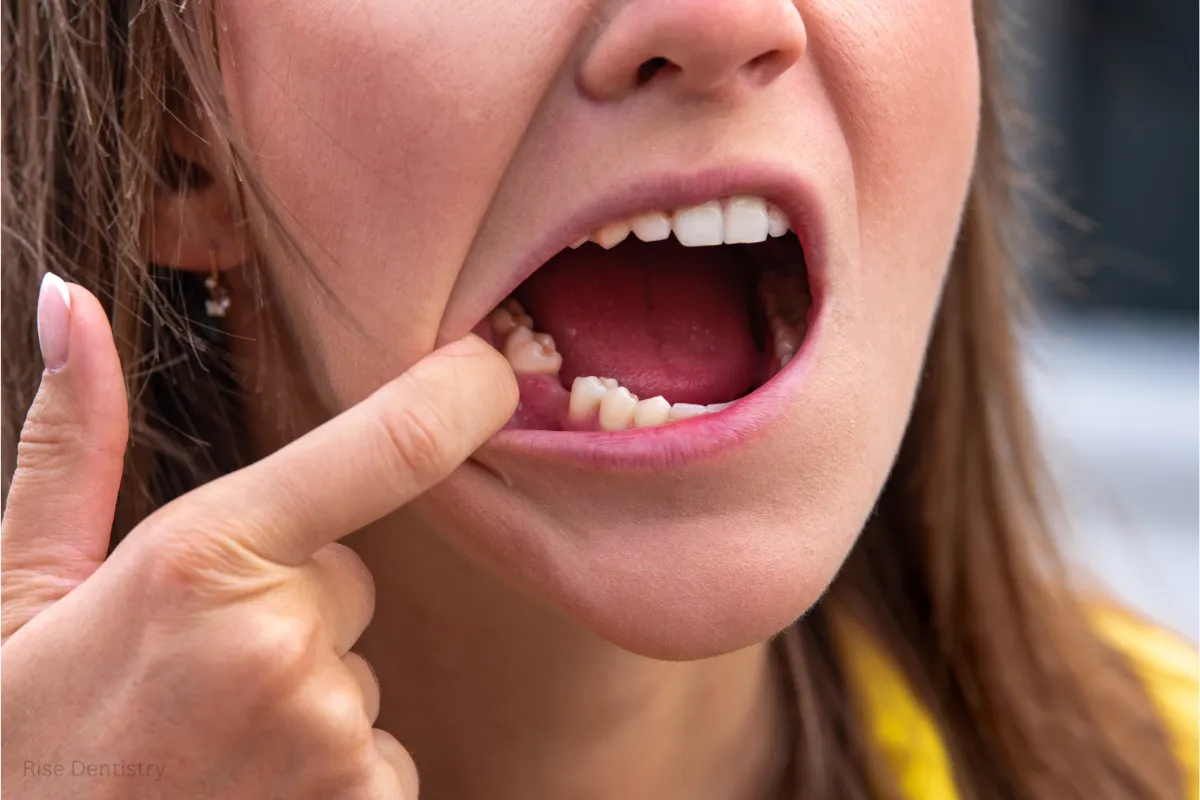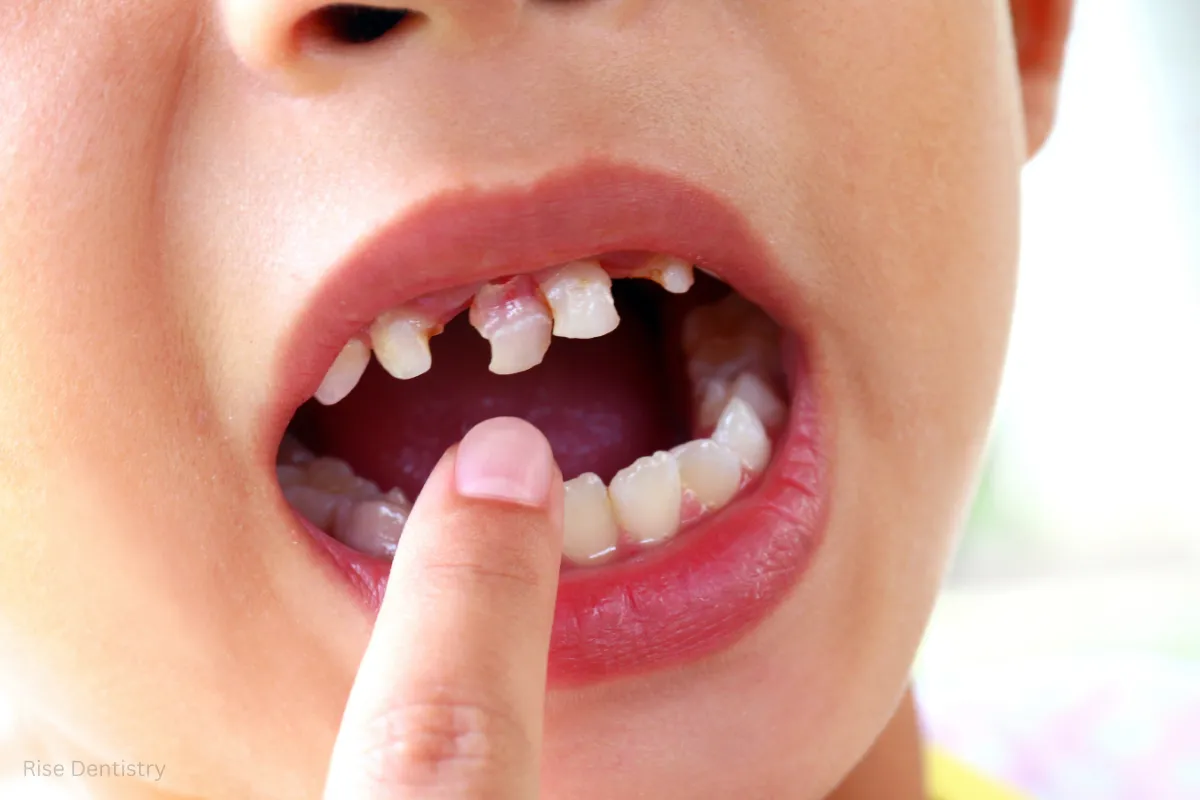
Is your child in need of a tooth extraction? Our gentle, expert care ensures a smooth and comfortable procedure. Contact us today to learn more about the process and how we can help your little one!
Tooth extraction for kids is a common procedure, and it’s often necessary for a child’s overall dental health. While the idea of extracting baby teeth might sound intimidating, it’s a safe and routine procedure. Dentists perform these extractions to help kids maintain proper oral development.
Pediatric tooth extractions are quick and minimally uncomfortable. They are typically performed to create space for permanent teeth or to remove teeth that are decayed or overcrowded.
At Rise Dentistry, we understand that a visit to the dentist can be stressful for both kids and parents. That’s why our family dentistry team creates a friendly, welcoming environment to ensure your child’s experience is as comfortable and positive as possible.

A child tooth extraction may be necessary when there’s overcrowding or if a tooth isn’t falling out naturally. In some cases, extractions make space for permanent teeth to come in properly.
Baby teeth extraction is often done to prevent future orthodontic issues. For example, extracting baby teeth to make room for permanent teeth can avoid more complicated treatments later on.
If your child’s tooth is severely decayed, it may need to be extracted to prevent further damage or infection. Extracting baby teeth due to decay ensures that the remaining teeth stay healthy and that permanent teeth can come in correctly.

To start, the pediatric dentist will apply a local anesthetic around the tooth to numb the area. This ensures that your child won’t feel any pain during the extraction process.
If your child is nervous, the dentist may use nitrous oxide (laughing gas) to help them relax. It’s a safe and gentle way to keep kids calm and comfortable during the procedure.
The dentist will then remove the tooth. The procedure is quick, and most children feel little to no discomfort. Afterward, the dentist will place gauze over the area to help with blood clot formation.
Recovery time is usually quick, but mild swelling or discomfort may last a few days. The dentist will provide aftercare instructions. Side effects of baby tooth extraction, like swelling or discomfort, are normal but should be monitored.
Most milk teeth will loosen and fall out on their own. It’s best to let this happen naturally.
If the tooth is wiggling but not falling out, gently pull it with clean hands or gauze. Pulling out milk teeth should be done carefully. Don’t force it—if it resists, wait.
If the tooth doesn’t come out easily or is causing discomfort, it’s time to visit a pediatric dentist. They can safely remove the tooth without pain.
If the tooth is stuck, a pediatric dentist is the best choice. They are trained to perform extractions quickly and safely, ensuring a smooth process for your child.
After a baby tooth removal, your child may experience mild swelling or discomfort. This is normal and usually improves within a few days.
Use the medication prescribed by your pediatric dentist to manage any pain. Follow their instructions carefully for the best results.
Offer soft foods like yogurt or applesauce for the first day. Avoid tough or crunchy foods that may cause discomfort or affect the healing of the extraction site. Make sure your child rests to speed up recovery.
Keep your child from using straws or spitting forcefully for 24 hours. This maintains the blood clot and promotes proper healing. Contact the dentist if there are any signs of infection.

Many parents worry about kids getting tooth pulled and whether it will hurt. The good news is that pulling a kids' tooth is usually quick and easy. Most kids experience very little discomfort during the procedure.
The dentist will apply a local anesthetic to numb the treatment area before the extraction begins. This ensures they feel no pain while the tooth is being removed. Some children may feel slight pressure or a little tugging, but it’s not painful.
If your child is anxious, the dentist may offer nitrous oxide (laughing gas) to help them relax. After the procedure, mild discomfort is normal but can be managed with over-the-counter pain relievers as recommended by the dentist.



Pain or Discomfort:
If your child is complaining of pain around a tooth, it might indicate that the tooth needs to be removed.

Swelling:
Swelling or tenderness around the tooth or gums could be a sign of infection or decay, suggesting the need for extraction.

Difficulty Chewing or Biting:
If your child is having trouble chewing or biting down, it may be due to the tooth causing issues.

Crowding or Tooth Decay:
A pediatric dentist will check if the tooth is causing crowding or decay. If needed, kids tooth extraction or pediatric dental extractions ensure proper development of permanent teeth.

The best age for tooth extraction depends on your child’s dental development. Generally, baby teeth start to fall out around age 6, but some children may need extractions earlier due to dental issues.
In rare cases, a 2-year-old tooth extraction may be necessary due to severe decay or injury. Early intervention prevents complications with baby teeth and the development of adult tooth.
A 4-year-old tooth extraction may be needed if a tooth is severely decayed or causing crowding. Addressing these issues early can avoid future complications with adult teeth.
By age 7, pediatric tooth extraction may be needed to create space for permanent teeth or to remove a stubborn baby tooth. This ensures the proper development of adult teeth.
The best age for tooth extraction depends on your child’s dental development. Generally, baby teeth start to fall out around age 6, but some children may need extractions earlier due to dental issues.
In rare cases, a 2-year-old tooth extraction may be necessary due to severe decay or injury. Early intervention prevents complications with baby teeth and the development of adult tooth.
A 4-year-old tooth extraction may be needed if a tooth is severely decayed or causing crowding. Addressing these issues early can avoid future complications with adult teeth.
By age 7, pediatric tooth extraction may be needed to create space for permanent teeth or to remove a stubborn baby tooth. This ensures the proper development of adult teeth.

Mild Swelling and Discomfort

Swelling and discomfort are normal and usually subside within a few days.

Minor Bleeding

A small amount of bleeding is typical immediately after the procedure and should stop within hours.

Pain Management

Use over-the-counter pain relievers as advised by the pediatric dentist to manage discomfort.

Cold Compress for Swelling

Apply a cold compress to the cheek for 15-20 minutes to reduce swelling.

Rest and Aftercare

Ensure your child rests and avoids using straws or spitting for 24 hours.

When to Contact a Pediatric Dentist

Ensure your child rests and avoids using straws or spitting for 24 hours.
Yes, tooth extraction for kids is completely safe. Dentists perform these procedures regularly with minimal discomfort.
Healing usually takes a few days. Swelling and discomfort should go away within 1-2 days after the procedure.
Most kids feel little to no pain during the procedure. A local anesthetic ensures the area is numb, so it’s not painful.
There is no strict minimum age. Tooth extractions may be needed as early as age 2 for severe decay or injury.
Usually, kids don’t need to be put to sleep. A local anesthetic is enough to keep them comfortable during the procedure.

Pediatric tooth extraction is safe and often necessary for your child’s dental health. With the right care, the process is quick and uncomplicated.
It’s important to consult with a pediatric dentist for guidance on your child’s specific needs. They can provide the best recommendations for your child’s oral health.
Remember, child tooth extraction recovery is usually fast, and your child will feel better in no time.
If you have any concerns, contact our pediatric dental team at Rise Dentistry. Schedule a consultation today to ensure the best care for your child’s smile.

© 2023-2025 Rise Dentistry. All rights reserved.